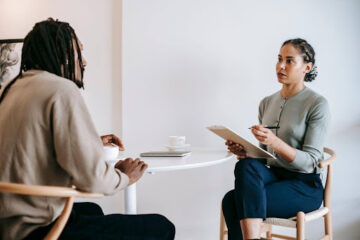
Body Language
Confidence is often described as the key to success in various aspects of life. Confidence plays a pivotal role, whether acing a job interview, delivering a presentation, or navigating social interactions. However, one aspect where confidence truly shines is in body language.
How we carry ourselves, our gestures, postures, and facial expressions, collectively known as body language, can significantly influence how others perceive us. In this blog, we’ll delve into the importance of confidence in body language and how it impacts our personal and professional lives.
Understanding Body Language
Body language serves as a powerful form of nonverbal communication, often conveying more than words alone. It encompasses a wide array of cues, including facial expressions, eye contact, posture, gestures, and even the tone of voice. While verbal communication provides information, body language adds depth and context to our messages, shaping how others interpret them.
Confidence manifests itself in several ways as a component of body language. It can be seen in the way we stand tall, maintain eye contact, gesture assertively, and speak with conviction. Conversely, a lack of confidence may be evident in a slouched posture, avoiding eye contact, fidgeting, and speaking softly or hesitantly.
The Impact of Confidence in Body Language
- First Impressions: They say first impressions are lasting impressions, which holds true in body language. When we exude confidence through our body language, we instantly appear more competent, trustworthy, and capable. This can be instrumental in various social and professional settings, from job interviews to networking events.
- Leadership and Authority: Confidence in body language is a hallmark of effective leadership. Leaders who display confidence command respect and inspire trust among their followers. Whether it’s addressing a team, negotiating with clients, or making critical decisions, leaders with strong body language exude authority and charisma, fostering a positive and productive work environment.
- Communication Effectiveness: Effective communication goes beyond mere words; it encompasses the entire spectrum of nonverbal cues. Confident body language enhances communication effectiveness by reinforcing the message we convey verbally. For instance, maintaining steady eye contact while speaking signals sincerity and engagement, while open gestures convey openness and approachability.
- Influence and Persuasion: Confidence is a persuasive trait. When we project confidence through our body language, we are more likely to sway opinions, win arguments, and influence decisions. Whether it’s persuading clients to close a deal or rallying support for a cause, confident body language can be a potent tool for achieving our objectives.
- Personal Empowerment: Beyond its impact on external perceptions, confidence in body language also shapes our internal state of mind. Adopting confident body language can actually boost our self-esteem and sense of empowerment. By embodying traits associated with confidence, such as poise, assertiveness, and resilience, we cultivate a positive self-image and overcome self-doubt.
- Mirroring and Rapport: Confident individuals often find it easier to establish rapport with others through mirroring. Mirroring involves subtly mimicking the body language of the person you’re interacting with, which can create a sense of connection and trust.
- Emotional Regulation: Confidence in body language also involves the ability to regulate emotions effectively. While it’s natural to experience nervousness or anxiety in certain situations, confident individuals are adept at managing these emotions and projecting calm and composure through their body language.
- Cultural Considerations: It’s essential to recognize that cultural norms and expectations can influence the interpretation of body language. What may be perceived as confidence in one culture could be seen differently in another. Being mindful of cultural nuances can help ensure that your body language aligns with the context of the situation.
- Practice and Feedback: Building confidence in body language takes practice and feedback. Take opportunities to observe and emulate individuals who exhibit strong body language. Additionally, seek feedback from trusted peers or mentors to identify areas for improvement and refine your nonverbal communication skills.
Practical Tips for Enhancing Confidence in Body Language
- Maintain Good Posture: Stand or sit up straight with your shoulders back. Good posture not only exudes confidence but also promotes physical well-being.
- Make Eye Contact: Maintain consistent but natural eye contact during conversations. It conveys attentiveness and interest in the interaction.
- Use Assertive Gestures: Employ purposeful gestures to emphasize your points. Avoid excessive fidgeting or closed-off gestures that may convey nervousness.
- Speak Clearly and Audibly: Project your voice and articulate your words clearly. Confidence is reflected not only in what you say but also in how you say it.
- Dress Appropriately: Wear attire that makes you feel comfortable and confident. Dressing well can enhance your self-assurance and overall demeanor.
Conclusion
Confidence is a game-changer in every aspect of life, and its importance is magnified when it comes to body language. How we carry ourselves speaks volumes about our self-assurance, competence, and credibility.
By cultivating confidence in our body language, we can elevate our personal and professional interactions, leaving a lasting impression on others and empowering ourselves in the process. So, stand tall, make eye contact, and let your body language exude the confidence that propels you toward success.
With practice and awareness, you can harness the power of confident body language to achieve your goals and forge meaningful connections in all areas of your life.
For more exciting news, visit: TimesInform










